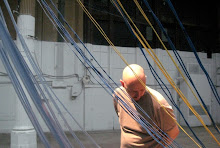...Andy Brick today. One cool thing is that he said he'd been getting traffic from this blog. I didn't know anyone was looking at this thing! How cool.
So if you haven't done so already, head on over to Andy's site and check out what he's up to. He's an incredible musician and a good egg besides.
In the meantime, I saw some great Turkish/Armenian music on Friday Night. It was a group called the 'Eurasian Project' at The Cell Theater on west 23rd street. The ensemble is Armenian-American oud master Ara Dinkjian, Turkish kanun virtuoso Tamer Pinarbasi, Macedonian Roma clarinetist Ismail Lumanovski, along with Seido Salifoskion on percussion.
This was a killer night of music! I really appreciated Sevgi dragging me out of my funk (which was running pretty deep for some reason) and taking me to this thing. As always her friends were very kind and welcoming to me. I always feel like I'm so inhibited around them that I act like the unibomber, but the next time, they're again welcoming and kind.
The Kanun player is a favorite of mine. I've seen him a number of times. When he plays, he always seems like he's above the technique -- like he has a mastery of the rudiments which is so deep he's completely free to perform from a joyous place, inventing what he's going to do next on the fly, interacting with the musicians with complete spontaneity. He's totally comfortable with the 'licks'.
Unfamiliar to most "western" musicians and listeners, the Kanun is an instrument similar to an autoharp in that it sits on the lap, but also similar to an orchestral harp in that it is tuned diatonically (the string's tunings correspond to the white keys on the piano). To get the "black keys", there are little tabs, or switches (called "mandals") which are manipulated by the player's left hand that change the pitch of the diatonic note. I should also note that while an autoharp is very easy to play (although I'm sure there are some tricky things possible) The kanun AIN'T EASY TO PLAY.
The difference between this and the action of a harp is that these "tabs" can be switched _very_ quickly and are switched on a single string (or "course", which is a group of stings - 3 in this case - tuned to the same pitch) at a time. This as opposed to globally on all octaves, which is how a harp works, with footpedals. Players can even play chromatic lines by switching them quickly between the notes available on a given course. They do a lot of tremolando type figures.
Anyway, this guy is one of the best, and if you get a chance check him out. I'm hoping to get him into the studio to add some things to a project I've been doing in my spare time, inspired by world music I've heard. When I approached him about this, he seemed more open this time, so maybe we can hook it up.
Here's the wikipedia article about the kanun
The surprise for me this time out was the clarinetist, who was fabulous. As luck would have it, I've been lucky to work with some of the best clarinetists in New York, so I have expectations about what the clarinet does and doesn't do. Mr. Lumanovski met and exceeded my quality expectations and surprised me with his pushing of the limits of the instrument.
His tone was gorgeous. It was unlike a typical clarinet sound - in that the one thing he never sounded like was typical western orchestral or chamber music clarinet. He played with an earthy tone that sounded like 'klezmer' clarinet. If you closed your eyes, sometimes he sounded like a single reed (which the clarinet is) and sometimes like a double reed (oboe for example is a double reed). Sometimes he produced a saxophone's tone. Sometimes he was almost inaudible, sometimes he wailed over the whole ensemble, producing a sea of fast moving notes. I thought: Does this dude ever breath? He kept stretching the limits of the range. He always was virtuostic, but at the same time coming from a deep emotional place.
Our oud player (I later discovered) was probably the most famous of the group, and also (perhaps as a result of his musical maturity) comfortably understated. I love some of the tunings on this instrument, because some of the notes on the instrument are wildly out of tune if compared with our western tunings, but that is what's appropriate for this music. Evocative.
The music? Well, I think it resembles jazz in terms of performance practice. In other words, they start with a tune that everyone knows (if you're Turkish, which I am not), then they improvise on that tune, going pretty much to the limits of their prowess while still referring to the tune.
It's interesting that I'm a little out to sea when I'm listening. I don't know the tunes, so I'm unfamiliar with the extent of the embelliment of it - like I would be with, say, 'My Funny Valentine'.
The sound you'd recognize, very middle eastern sounding scales and tunings..exuberant rhythmic figures...sort of a joyous sadness.
I also love that the time signatures are also often lopsided, but they groove completely organically, so that you're sitting there listening -- utterly without that sense of a slapped together 'oh-aren't-your-meters-so-complicated' feel -- and you suddenly think ... "are these guys in 9?"
Yep, they're in 9...
Sunday, June 15, 2008
Subscribe to:
Post Comments (Atom)

No comments:
Post a Comment